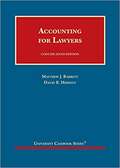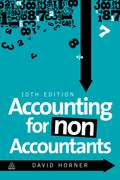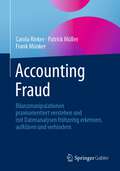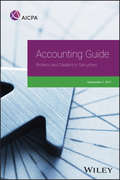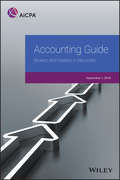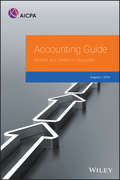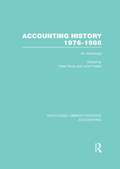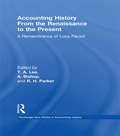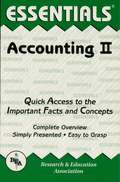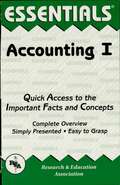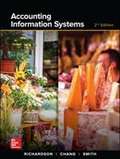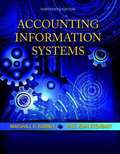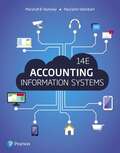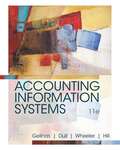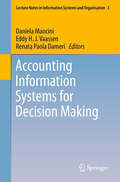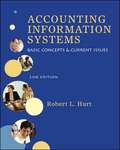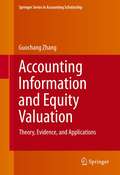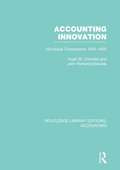- Table View
- List View
Accounting For Lawyers, Concise
by Mathew J. Barrett David R. HerwitzNow in its sixth edition, the concise version of this widely adopted text responds to the demand for a concise, efficient casebook that introduces novices to financial statements and how accounting issues frequently arise in the practice of law, both in transactional work and litigation. Designed specifically for one- and two-credit hour courses for law students with no accounting background, the text of the Concise Sixth Edition is about forty percent shorter than the Sixth Edition, so students will find this text less expansive and easier to master. The first section of each chapter, entitled "Importance to Lawyers," explains how the topics discussed in that chapter affect lawyers and their clients. The text empowers students: To work backwards through the bookkeeping process and, when necessary, to trace an amount that appears on the financial statements through the accounting records to the ledgers, journals, and supporting documentation; To negotiate agreements or other legal documents containing accounting terminology or concepts; To recognize “red flags” that suggest financial difficulties--or even financial fraud; and To understand--and, when necessary, defend against--the opportunities to obtain accounting-related information about an underlying lawsuit and then to use that information during litigation. Like its predecessor, the Concise Sixth Edition uses a “learn by doing” approach, including: Illustrative financial statements from Starbucks Corporation Multiple problems using the financial statements from Amazon.com, Inc., Alphabet Inc., and United Parcel Service, Inc.
Accounting For Non-accountants
by David HornerNow in its 10th edition, Accounting for Non-Accountants provides the perfect introduction to the basics of accounting and finance. Designed for non-specialists with little or no background in accounting, it guides readers through the maze of financial terms and accounting concepts and techniques in a clear and easy-to-follow style. Updated for 2015, Accounting for Non-Accountants includes information on the new UK GAAP accounting standards as well as an overview of current international standards, and is structured to provide in-depth understanding in three key areas: annual accounts (including income statements, balance sheets, cash flow and reporting standards); management accounting (costing, marginal costing and budgetary controls); and financial management (including the cost of capital, working capital, investment appraisal and performance analysis).
Accounting Framework, Financial Statements, and Some Accounting Concepts
by William J. Bruns Jr.Introduces the accounting framework, basic financial statements, and eleven accounting concepts.
Accounting Fraud at Tesco Stores (A)
by Suraj Srinivasan Jonas Heese Julia KelleyThis case describes the accounting fraud at Tesco Stores Limited (TSL), which was discovered by a senior accountant in TSL's finance department. The accountant was concerned about TSL's handling of commercial income, which, according to the accountant, overstated Tesco's profit by an estimated 246 million. Beyond the accounting issue, the case describes Tesco's organizational and cultural shortcoming causing this problem, how Tesco's new CEO Dave Lewis responded to the allegations, and how the court held the Tesco accountable for its fraudulent accounting. In September 2014, Amit Soni, a senior accountant in Tesco Stores Limited's (TSL) finance department filed a report with Tesco's legal team. Soni was concerned about TSL's handling of commercial income. According to the accountant's allegations, TSL employees had been inflating commercial income to meet the division's financial targets, causing Tesco's projected trading profit for the six months ended August 23, 2014 to be overstated by an estimated 246 million. Tesco's legal team had quickly referred the issue to CEO Dave Lewis, who had started in the role just a few weeks earlier, on September 1. Lewis had to decide how to respond to these allegations. Did the allegations have merit and what are the causes for the accounting violations? Should managers be removed if Tesco determined that the allegations had merit? What were the legal consequences for Tesco and how should Tesco's organizational structure and culture evolve?
Accounting Fraud at WorldCom
by Robert S. Kaplan David KironThe principal players in WorldCom's accounting fraud included CFO Scott Sullivan, the General Accounting and Internal Audit departments, external auditor Arthur Andersen, and the board of directors. The case provides sufficient detail to allow for a full discussion of the pressures that lead executives and managers to "cook the books," the boundary between earnings smoothing or management and fraudulent reporting, the role for internal control systems and internal audit to prevent or rapidly detect accounting fraud, the expectations about governance processes performed by external auditors and the board of directors, and the pressure and consequences when middle managers follow orders that they know are wrong. Written from the public record, the case contains numerous quotes from an individual involved in the WorldCom fraud that were reported by the Investigative Committee and Wall Street Journal articles about several of the individuals caught up in the situation.
Accounting Fraud: Bilanzmanipulationen praxisorientiert verstehen und mit Datenanalysen frühzeitig erkennen, aufklären und verhindern
by Carola Rinker Patrick Müller Frank MünkerDieses Buch beschreibt, welche typischen Fälle von Bilanzmanipulationen auch im Alltag von Konzernen und KMUs vorkommen können, durch Mitarbeiter und Dienstleister. Das Bewusstsein für Accounting Fraud ist oft nicht vorhanden. In diesem Buch werden branchentypische Besonderheiten der Bilanz und GuV aufgegriffen. Die Autoren erläutern verschiedene Manipulationsarten und zeigen, wie diese aufgedeckt werden können. Zudem wird erklärt, welche Maßnahmen Unternehmen zur Früherkennung und Prävention ergreifen können, beispielsweise durch den Einsatz forensischer Datenanalyse. Dieses Buch veranschaulicht, wie wichtig es für Praktiker ist, sich dem Thema zu widmen, auch anhand von Praxisbeispielen.
Accounting From the Outside: The Collected Papers of Anthony G. Hopwood (Routledge Library Editions: Accounting)
by Anthony G. HopwoodThe 43 papers in this collection, originally published from 1972 to 1987 delve into accounting, observing and exploring its functioning. They construct a basis for interrogating it in use and indeed they attempt to account for accounting. The author seeks to understand accounting, to appreciate what it is, what it does and how it does it, examining it from without rather than from within.
Accounting Guide: Brokers and Dealers in Securities
by AicpaThe 2017 edition gives up-to-date industry-specific guidance needed to be able to tailor operations with the most current standards and regulations. Included are new best practices and interpretive guidance to industry-specific considerations, this guide has you covered. This edition offers “best practice” discussion of industry-specific issues such as fair value accounting and related disclosures, as well as compliance with regulatory requirements. Further, new guidance on initial margin has been approved in accordance with applicable AICPA requirements.
Accounting Guide: Brokers and Dealers in Securities 2018 (AICPA)
by AicpaThe 2018 edition gives up-to-date industry-specific guidance needed to be able to tailor operations with the most current standards and regulations. Included are new best practices and interpretive guidance to industry-specific considerations, this guide has you covered. <P><P> This edition offers “best practice” discussion of industry-specific issues such as fair value accounting and related disclosures, as well as compliance with regulatory requirements. Further, new guidance on initial margin has been approved in accordance with applicable AICPA requirements.
Accounting Guide: Brokers and Dealers in Securities 2019 (AICPA)
by AicpaIt is critical to understand the complexities of the specialized accounting and regulatory requirements needed for the broker-dealer industry. This comprehensive guide has been designed to be beneficial for a wide range of professionals within the broker-dealer industry. Updates to this edition are to conform the content to current accounting standards and regulatory requirements. The updates include: SEC Release No. 34-86073, Amendment to Single Issuer Exemption for Broker-Dealers; ASU No. 2018-09, Codification Improvements; and, SEC Release Nos. 33-10532; 34-83875; IC-33203, Disclosure Update and Simplification. In addition, this edition features a new example disclosure note for revenue from contracts with customers, which has been added to the guide's illustrative financial statements and footnote disclosures.
Accounting History 1976-1986: An Anthology (Routledge Library Editions: Accounting)
by Peter Boys John FreearThe journal Accounting History was published in eight volumes intermittently between 1976 and 1986. It had a relatively small circulation and this re-issue of its anthology provides the opportunity for many of the articles which appeared in the journal over the years to once again reach a wider audience. The volume begins with items of a general nature, covering the importance of preserving accounting records and accounting history in general. Subsequent categories deal with the methodology of historical accounting research, government accounting, taxation, bankruptcy, professional accountancy and accounting theory, as well as auditing and management accounting.
Accounting History from the Renaissance to the Present: A Remembrance of Luca Pacioli (Routledge New Works in Accounting History)
by T. A. Lee R. H. Parker A. BishopFirst published in 1996. Routledge is an imprint of Taylor & Francis, an informa company.
Accounting I Essentials
by Duane MilanoREA's Essentials provide quick and easy access to critical information in a variety of different fields, ranging from the most basic to the most advanced. As its name implies, these concise, comprehensive study guides summarize the essentials of the field covered. Essentials are helpful when preparing for exams, doing homework and will remain a lasting reference source for students, teachers, and professionals. Accounting I includes accounting principles, the accounting cycle, adjusting entries, closing entries, worksheet procedures, accounting for a merchandising operation, internal control and specialized journals, cash, receivables, inventory, property, plants and equipment, and long-term assets.
Accounting I Essentials
by Duane MilanoREA’s Essentials provide quick and easy access to critical information in a variety of different fields, ranging from the most basic to the most advanced. As its name implies, these concise, comprehensive study guides summarize the essentials of the field covered. Essentials are helpful when preparing for exams, doing homework and will remain a lasting reference source for students, teachers, and professionals. Accounting I includes accounting principles, the accounting cycle, adjusting entries, closing entries, worksheet procedures, accounting for a merchandising operation, internal control and specialized journals, cash, receivables, inventory, property, plants and equipment, and long-term assets.
Accounting Information Systems
by Vernon Richardson Chengyee Janie Chang Rod E. SmithAccounting Information Systems 2e covers the four roles for accountants with respect to information technology: users of technology and information systems, managers of users of technology, designers of information systems, and evaluators of information systems. Accountants must understand the organization and how organizational processes generate information important to management. <p><p> The focus of Accounting Information Systems, 2/e is on the accountant's role as business analyst in solving business problems by database modeling, database design, and business process modeling. Unlike other texts that provide a broad survey of AIS related topics, this text concentrates on developing practical, real-world business analysis skills. Whether you are developing a new course for AIS or incorporating AIS materials into your existing curriculum, Accounting Information Systems, 2/e will help prepare your students for their future careers.
Accounting Information Systems
by Marshall B. Romney Paul John SteinbartFor undergraduate and graduate courses in AIS The market-leading text with the most comprehensive, flexible coverage of AIS available. This market-leading text delivers the most comprehensive and flexible coverage of the our major approaches to teaching AIS, while allowing instructors the flexibility to reorder chapters and focus the material to suit their individual course needs. This new edition has been updated to cover all of the most recent developments in AIS and to show AIS has changed the roles of an accountant.
Accounting Information Systems
by Marshall Romney Paul SteinbartAccounting Information Systems, 14th Edition covers all of the most recent updates in AIS, including how developments in IT affect business processes and controls, the effect of recent regulatory developments on the design and operation of accounting systems, and how accountants can use the AIS to add value to an organization. Not only will readers see how AIS has changed the role of an accountant, but they’ll also be prepared for a successful accounting career in public practice, industry, or government.
Accounting Information Systems
by Patrick Wheeler Ulric J. Gelinas Richard B. Dull Mary Callahan HillAs an accounting professional, you are expected to help organizations identify enterprise risks and provide quality assurance for the company's information systems. <P><P>You can rely on ACCOUNTING INFORMATION SYSTEMS, 11E's clear presentation to help you understand the two issues most critical to accounting information systems in use today: enterprise systems and controls for maintaining those systems. <P><P> ACCOUNTING INFORMATION SYSTEMS, 11E explores today's most intriguing accounting information systems (AIS) topics and details how these issues relate to business processes, information technology, strategic management, security, and internal controls. The authors focus on today's most important advancements, using a conversational tone rather than complex technical language to ensure you develop the solid foundation in AIS that you need to be successful.
Accounting Information Systems for Decision Making (Lecture Notes in Information Systems and Organisation #3)
by Daniela Mancini Renata Paola Dameri Eddy H. VaassenThis book contains a collection of research papers on accounting information systems including their strategic role in decision processes, within and between companies. An accounting system is a complex system composed of a mix of strictly interrelated elements such as data, information, human resources, IT tool, accounting models and procedures. Accounting information systems are often considered the instrument by default for accounting automation. This book aims to sketch a clear picture of the current state of AIS research, including design, acceptance and reliance, value-added decision making, interorganizational links, and process improvements. The contributions in this volume emphasize that AIS has grown into a powerful strategic tool. The book provides evidence for this observation by examining a wide range of current issues ranging from theory development in AIS to practical applications of accounting information systems. In particular it focuses on themes of growing interest in the realm of XBRL and Financial Reporting, Management Information Systems, IT/IS Audit and IT/IS Compliance. The book will be of interest to financial and managerial accountants and IT/IS practitioners, including information systems managers and consultants.
Accounting Information Systems: A Practitioner Emphasis
by Cynthia Heagy Constance LehmannMany AIS textbooks do not explain the basic structure of an entire accounting information system. When students finish this textbook, they will really understand an accounting system. Some books focus more on technology topics than basic accounting system topics. Few accounting graduates will apply for jobs to build databases. Most will be users, auditors, and implementers of accounting systems and need to understand how accounting software works. As a result, this book has a practitioner emphasis, not a systems development emphasis as do many accounting textbooks. Intended to meet the needs of a first course in accounting information systems at either the undergraduate or graduate level, this textbook may also be used as a review text in second or subsequent courses in this area.
Accounting Information Systems: Basic Concepts and Current Issues (2nd Edition)
by Robert HurtHurt's Accounting Information Systems, 2e continues to take a fresh new approach that puts judgment and critical thinking, not technology, at the heart of the AIS course. Using a conversational writing style appealing to students, this book presents AIS as an art as much as a science. AIS is presented as a set of fundamental ideas and concepts that can be applied in various organizational contexts. Students are provided with vocabulary they will need to succeed in the profession and ensuring that they can communicate clearly and effectively about accounting information systems with both accountants and nonaccountants. The text end-of-chapter exercises and assessment tools are all competency-based, distilling knowledge to its essential elements and then encouraging students to use those essential elements to think for themselves.
Accounting Information and Equity Valuation: Theory, Evidence, and Applications (Springer Series in Accounting Scholarship #6)
by Guochang ZhangThe purpose of this book is to offer a more systematic and structured treatment of the research on accounting‐based valuation, with a primary focus on recent theoretical developments and the resulting empirical analyses that recognize the role of accounting information in making managerial decisions. Since its inception, valuation research in accounting has evolved primarily along an "empirically driven" path. In the absence of models constructed specifically to explain this topic, researchers have relied on economic intuition and theories from other disciplines (mainly finance and economics) as a basis for designing empirical analyses and interpreting findings. Although this literature has shed important light on the usefulness of accounting information in capital markets, it is obvious that the lack of a rigorous theoretical framework has hindered the establishment of a systematic and well‐structured literature and made it difficult to probe valuation issues in depth. More recently, however, progress has been made on the theoretical front. The two most prominent frameworks are (i) the "linear information dynamic approach" and (ii) the "real options‐based approach" which recognizes managerial uses of accounting information in the pursuit of value generation. This volume devotes its initial chapters to an evaluation of the models using the linear dynamic approach, and then provides a synthesis of the theoretical studies that adopt the real options approach and the empirical works which draw on them. The book also makes an attempt to revisit and critique existing empirical research (value-relevance and earnings-response studies) within the real options-based framework. It is hoped that the book can heighten interest in integrating theoretical and empirical research in this field, and play a role in helping this literature develop into a more structured and cohesive body of work. Value is of ultimate concern to economic decision-makers, and valuation theory should serve as a platform for studying other accounting topics. The book ends with a call for increased links of other areas of accounting research to valuation theory.
Accounting Innovation: Municipal Corporations 1835-1935 (Routledge Library Editions: Accounting)
by Hugh M. Coombs and John Richard EdwardsThe period 1835-1935 saw the development of the structure of local government which remains broadly intact today and also the growth of modern financial reporting procedures. This book examines the accounting implications of these developments and places them within the social and organisational contexts in which the events took place. The research is based on the contents of government reports, contemporary literature dating from the mid 1870s and the archival records of five municipal corporations – Birmingham, Bradford, Bristol, Cardiff and Manchester.
